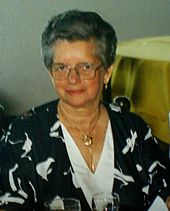
Dilia Díaz Cisneros
Encyclopedia

El Hatillo Municipality, Miranda
El Hatillo Municipality is an administrative division of the State of Miranda, Venezuela; along with Baruta, Chacao, Libertador and Sucre, it is one of the five municipalities of Caracas, the capital of Venezuela...
, June 1, 1925) is a Venezuela
Venezuela
Venezuela , officially called the Bolivarian Republic of Venezuela , is a tropical country on the northern coast of South America. It borders Colombia to the west, Guyana to the east, and Brazil to the south...
n teacher and poet, founder of the public schools "Bogotá", "Los Jardines" and "Caracciolo Parra León" in Caracas
Caracas
Caracas , officially Santiago de León de Caracas, is the capital and largest city of Venezuela; natives or residents are known as Caraquenians in English . It is located in the northern part of the country, following the contours of the narrow Caracas Valley on the Venezuelan coastal mountain range...
.
Being born at El Hatillo town
El Hatillo Town, Miranda
El Hatillo Town is the seat of El Hatillo Municipality in Miranda, Venezuela....
of the Miranda state
Miranda (state)
Miranda State is one of the 23 states into which Venezuela is divided. It is ranked second in population among Venezuelan states, after Zulia State. In June 30, 2010, it had approximately 2,987,968 residents. It also has the greatest Human Development Index in Venezuela, according to the...
, starts her studies in the rural school of El Hatillo, specializing at manualities. Graduates as teacher at the "Gran Colombia" school in Caracas. From her graduation in 1947, dedicates her life to the education, working at the "Andrés Bello" Federal school (1947 - 1950), teacher of the "José Mariá España" National school (1961 - 1965), manualist teacher a the "Pestalozzi" Center (1960 - 1978). In 1965, founds the National school "Bogotá", being the director until 1968, that year founds the National school "Los Jardines", directing this institution until 1971, when funds the National school "Caracciolo Parra León". On July 1, 1978 gets the jubilation from the Venezuelan education ministry. Also, Díaz Cisneros has wrote during her career, school poems, anthems, and declamations, has been the author of the anthems of the "Caracciolo Parra León" and "Pestalozzi" institutes, some of her poems has been published at the Cadena Tricolor.
In 1947 married with Venezuelan musician Victor Guillermo Ramos Rangel
Victor Guillermo Ramos Rangel
Victor Guillermo Ramos Rangel was born in Cúa, Miranda state, Venezuela, February 10, 1911, started as a musician at the Caracas Musical Declamation Academy , in that school obtain the composition degree, was one of the first students of Vicente Emilio Sojo, also one of the founders of the...
.
Source
- Review by Cecilia de Nuñez for the promotion Dilia Díaz de Ramos of the Pestalozzi Center, 1978.

